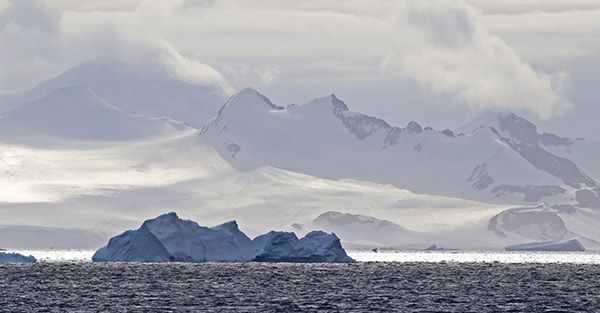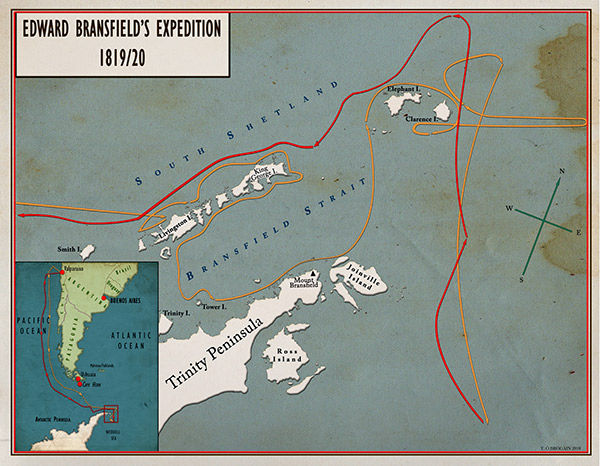Edward Bransfield—the Corkman who discovered Antarctica
Published in 18th-19th Century Social Perspectives, 18th–19th - Century History, Features, Issue 1 (January/February 2019), Volume 27A great discovery that has been plagued by controversy for two centuries.
By Michael Smith
The dark scudding clouds and misty haze parted briefly in the late afternoon to reveal the wondrous sight of an icy landscape never seen by human eyes before that moment. It was 30 January 1820 and Edward Bransfield, an accomplished navigator from Cork, had made the first sighting of the desolate mainland of Antarctica.
Bransfield’s discovery set in motion 100 years of Antarctic exploration that produced a series of epic exploits and famous polar adventurers from Ireland such as Tom Crean, Francis Crozier and Ernest Shackleton. Without his pioneering expedition the story of Antarctic exploration might be entirely different, yet Bransfield is a largely unrecognised figure from the past whose great discovery has been plagued by controversy for two centuries.

Press-ganged
Edward Bransfield’s story began in the small community of Ballinacurra, near Midleton, Co. Cork, where he was born in 1785. He appears to have been fairly well educated and to have picked up useful seafaring skills working on his father’s small boat among the waterways of Cork.
His peaceful life changed dramatically in the summer of 1803, when the feared press-gangs from the British navy descended on the Cork area in search of sailors to man the ships for Britain’s war with Napoleon.
Bransfield was apparently seized somewhere between Cork and Youghal and was thrust into the rigorously enforced British naval blockade of key French ports, such as Brest on the coast of Normandy or Toulon in the Mediterranean. He survived the brutal conflict—around 100,000 Royal Navy seamen were killed—and advanced steadily through the ranks to become ship’s master with special responsibility for navigation.
Posted to South America
Bransfield had clearly found his calling and remained in the navy when the war came to an end after Napoleon’s defeat at Waterloo in 1815. By 1817 he was master of the veteran frigate Andromache, which had begun life as a French warship before being captured by the British. Under Bransfield’s navigation, the Andromache was posted to the South American port of Valparaiso to safeguard British interests during Chile’s struggle for independence from Spain.
A different type of challenge arose in early 1819, when the English merchant vessel Williams was rounding stormy Cape Horn with a cargo of tobacco, clothing and medicines and tracked south into the Drake Passage in search of more favourable winds. William Smith, part-owner and captain of the Williams, was astonished to see land not marked on any charts and duly reported his discovery to the British authorities in Valparaiso in line with the empire-building spirit of the times.
The most senior naval officer in the area was Captain William Shirreff of the Andromache, who, for reasons that are not clear, ignored Smith’s findings. Undeterred, Smith took the Williams round the Horn twice more in 1819 and was luckier on his third voyage. In October 1819 he rediscovered the uncharted land that he had stumbled on earlier, which later turned out to be part of a string of eleven islands about 500 miles south of Cape Horn, now known as the South Shetland Islands. To avoid any doubts, Smith made a brief landing on one island and hurried back to Valparaiso with the news.
Amid growing rumours that American whalers were heading south in search of fresh hunting grounds, Captain Shirreff finally acted. He summoned Ship’s Master Bransfield and ordered him to take the Williams to investigate Smith’s discovery.

Ordered to ‘conceal every discovery’
Bransfield, who was 34 years old, sailed from Valparaiso on 20 December 1819 with orders to verify Smith’s findings, chart new discoveries and observe any wildlife or inhabitants encountered. He was to take possession of any new lands for the Empire but was commanded to ‘conceal every discovery that you may have made during your voyage’. He took provisions for twelve months. The Williams, a two-masted vessel of 216 tons, set off alone on a 2,000-mile journey into mostly unknown waters and immediately ran into difficulties. It took nine days to travel the first six miles. Fog, a common feature of the Drake Passage, later hampered visibility and it was three weeks before the South Shetlands came into clear view.

On 22 January 1820 Bransfield took a party ashore on King George Island to raise the flag on the Empire’s most southerly outpost. Next day the first rock specimens ever taken from Antarctica were collected. Bransfield sailed along the southern shores of the island chain before turning south into unexplored seas. The stretch of water that separates the South Shetlands from the Antarctic Peninsula (now known as Trinity Peninsula at its tip) by around 60 miles is today called the Bransfield Strait and is among the main thoroughfares carrying tourists to the continent.
Mainland Antarctica sighted
On 30 January 1820 all hands were amazed as the misty haze parted. Midshipman Charles Poynter recorded the moment: ‘At 3 our notice was arrested by three very large icebergs and 20 minutes after we were unexpectedly astonished by the discovery of land . . .’. Poynter reported being ‘half encompassed with islands’. The land, he explained, appeared as ‘immense mountains, rude crags and barren ridges covered with snow’, and he wondered whether the party had confirmed ‘the long contested existance [sic] of a Southern Continent’.

The expedition had discovered the north-western slopes of the Antarctic Peninsula, which Bransfield named Trinity Land after the Trinity House maritime body. A visible peak that rises to 2,500ft was later named Mount Bransfield. Bransfield sailed the Williams through some atrocious weather and established a ‘furthest south’ of 64° 56´ S in the outer reaches of the Weddell Sea. Before turning north, the ship passed the bleak Elephant Island, where less than 100 years later Shackleton’s men from the Endurance would be marooned.
Captain Fabian Gottlieb von Bellingshausen
After a remarkable journey lasting four months, the Williams crept back to Valparaiso in mid-April 1820. Not a man was lost. Meanwhile, however, the controversy that has tormented Bransfield’s legacy for 200 years was unfolding on the other side of the continent. Captain Fabian Gottlieb von Bellingshausen, an experienced Russian naval mariner, was navigating waters in the Vostok and the Mirny about twenty miles from the Antarctic coastline near territory today called Dronning Maud Land. On 27 January—three days before Bransfield’s sighting—Bellingshausen observed ‘continuous ice’ and ‘ice mountains’ in a southerly direction.
Crucially, Bellingshausen did not mention land in his official reports and did not distinguish between ice and solid ground. Nor did he ever claim to have been the first to set eyes on the Antarctic mainland. Contemporary newspaper accounts published in 1821, after the expedition returned home, quoted Bellingshausen as saying that ‘. . . there is no southern continent or should there be one, it must be inaccessible from being covered with perpetual snows, ice, etc.’.
By unhappy coincidence, the expeditions of both Bransfield and Bellingshausen failed to arouse much interest at home. Bellingshausen’s account of his expedition did not appear for ten years and it was not until 1945 that the first detailed English version of the voyage was finally published. The original manuscript of Bellingshausen’s book, his expedition journals and the naval records of the expedition have all vanished.
Midshipman Poynter’s journal
Bransfield suffered the indignity of official indifference and the loss of crucial documents. The logbook of the Williams disappeared and has never been found, which left Bransfield’s claim reliant on the surviving charts and some magazine articles from the 1820s. The most significant development, however, was the discovery in the 1990s of the journal kept by Midshipman Poynter, which contains a valuable first-hand account of the expedition.
More recent research by Rip Bulkeley has cast fresh doubts on Bellingshausen’s claims. After the most thorough study of the Russian documents ever made in English, Bulkeley concluded that ‘. . . Bellingshausen was not the first commander to see the Antarctic mainland . . .’.
Bransfield went back to sea as a merchant mariner and drifted into obscurity. We know very little about his later life, except that he married three times and appears never to have had children. He settled on the south coast of England and maintained a close interest in seafaring. The enigma has grown over the years because no photograph or painting of Bransfield has been found. No account of his expedition was ever written to lend weight to his claim of being the first to see and accurately chart the mainland of Antarctica.
Edward Bransfield died a forgotten man in Brighton on 31 October 1852 at the age of 67. He outlived his rival Bellingshausen by nine months.
Michael Smith is the author of An unsung hero: Tom Crean—Antarctic survivor (Collins Press, 2009) and Shackleton: by endurance we conquer (Collins Press, 2014).
FURTHER READING
R. Bulkeley, Bellingshausen and the Russian Antarctic Expedition 1819–21 (London, 2014).
R.J. Campbell (ed.), The discovery of the South Shetland Islands, 1819–1820: the journal of Midshipman C.W. Poynter (London, 2000).
M. Smith, Great endeavour—Ireland’s Antarctic explorers (Cork, 2010).
Plans to erect a memorial to Edward Bransfield are being coordinated by ‘Remembering Edward Bransfield’ (www.rememberingedwardbransfield.ie), a voluntary group that is raising funds to unveil a monument in Ballinacurra, Co. Cork, on 30 January 2020 to commemorate the 200th anniversary of the first sighting of Antarctica.
















